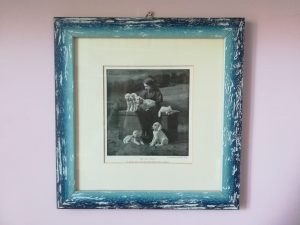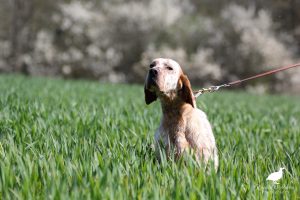Quattro passi dentro casa: le cornici blu
Le cornici blu, come è giusto che sia, guardano dall’alto al
basso il telo cinese. Sono arrivate prima di lui, molto, molto prima. Ridendo e
scherzando, credo se ne stiano attaccate al muro da almeno una quindicina
d’anni. Sempre nella stessa posizione e sempre sopra la stessa pittura color
malva che mi ha reso inconfondibile tra i commessi del colorificio locale. Che
ci vada di persona, o che mandi l’imbianchino, il contenuto della latta non
deve essere rosa, ma non deve nemmeno essere viola. Guai a virare verso il
color lavanda, è troppo freddo, dobbiamo stare il quanto più vicini possibile
al color malva. Che poi è quasi sinonimo del color erica in fiore: dipende
dalla luce, tante cose dipendono dalla luce.
A proposito di colori freddi, non credo si vedrà mai una parete gialla
in questa casa, il color malva si abbia perfettamente al blu delle cornici. È
un blu che è tanti blu insieme: distalmente, così diciamo in anatomia, troviamo
un blu abisso, muovendoci verso l’interno, invece, abbiamo un azzurro chiaro
caraibico, commercialmente noto anche come “Bahamas Blue”. Le sfumature sono
interrotte da venature bianco azzurro. Descritte così, le mie cornici potrebbero
sembrare la seconda cinesata nel raggio di pochi centimetri: niente di più
falso, nell’insieme, l’effetto complessivo è piacevole.
Non posso dirvi dove le ho comprate, non perché debba
rimanere un segreto, semplicemente non me lo ricordo: ricordo di averle
comprate io, di questo ne conservo la certezza, ma ho dei buchi nella memria
simili a quelli di un gruviera. Credo provengano da una specie di brico locale,
uno di quelli che da un anno all’altro cambiano nome e proprietà, con
l’assortimento che, tuttavia, rimane all’incirca lo stesso. Però, potrebbero
anche provenire dal brico supremo, quello che sta a una ventina di chilometri
da qui e che non nomino perché mi mette troppa soggezione: è troppo lontano per
pensare di andarci. Ho visto gente rimettere a nuovo la casa durante queste
giornate di quarantena. C’è una casetta bianca, qualunque, lungo il tratto in
cui passeggio con i cani. In meno di un mese la sua recinzione è diventata più
nera, le sue persiane più verdi, e i suoi muri più bianchi. Se non si può
uscire di casa, da dove saranno arrivate tutta quella pittura e tutti quei
pennelli?
Comunque, tornando alle cornici blu, costoro sono un numero
di cinque, non ricordo esattamente il perché. Tre alloggiano stampe di
fotografie dell’inizio del secolo scorso , due invece delle copie di fotografie
in bianco e nero scattate negli anni ’70.
C’è però un incredibile trait d’union, tutte le immagini portano
dei setter inglesi. Prima di parlarvi delle immagini, devo parlarvi dei passpartout,
perché hanno una storia tutta loro. A comprare una cornice pronta ed infilarci
dentro una foto siamo capaci tutti, ci costa anche molto meno che far fare una
cornice su misura, il problema arriva quando gli abbinate ciò che dovrebbe contenere.
Le anime semplici si accontentano di far combaciare i bordi dell’immagine con
quelli della cornice: la gradevolezza del risultato lascia però molto a
desiderare. Tutti abbiamo almeno
un’immagine imprigionata in questa maniera, ma… ecco vi lascio i puntini di
sospensione, così potete decidere come pensarla.
La soluzione preferita da
pignoli-perfezionisti-ossessivi-compulsivi? Il passepartout della giusta
tonalità e della giusta misura. Ora che ci penso, perché il beige del
passpartout centrale è più crema degli altri, che danno invece sul corda? Chi
lo sa, ho impattato con l’ennesimo buco del gruviera. Nell’anno di nascita
delle cornici blu non esistevano ancora i tutorial su Youtube, però avrei
potuto aggrapparmi ai ricordi delle lezioni di educazione tecnica delle scuole
medie. Ci ho pensato, ma non ci ho neanche provato: è inutile cercare di fare
il salto dalla teoria alla pratica, se sai già che quanto allungherai la gamba
cadrai prima di toccare l’altra sponda.

Se esistesse una classifica del senso pratico, il mio sarebbe sotto lo zero. Con la manualità va un po’ meglio, ma sostanzialmente io sono quella che ha le idee, mi aspetto che siano gli altri a realizzarle. Le mie idee, ovviamente, sono ottime, solo difficili da mettere in pratica. È per questo che i commessi dei brico, i fabbri, gli imbianchini, i falegnami, insomma gli artigiani in genere, preferiscono non avermi come committente. Ricorrono a mille astuzie per non farsi trovare, ma nulla possono contro la mia determinazione. Mi evitano perché sanno di non poter essere scortesi: negli anni, infatti, ho elaborato un sistema di rottura di scatole raffinato ed efficace, nonché a prova di insulto. Perché se io rompo, usuro, consumo, trito…. ma in fondo sono educata e gentile, anche se vorrebbero tanto mandarmi a quel paese non ho fornito loro le munizioni per poterlo fare. In fondo sono persino buona: consapevole della mia totale assenza di senso pratico, affermo spesso che il mio coinquilino ideale sarebbe un caporeparto del Leroy Merlin.
Comunque, quando venne l’ora dei passepartout, la vittima
designata fu un anziano corniciao locale. Con poco entusiasmo, li realizzò, facendomeli
pagare a caro prezzo e poi narrò la vicenda al figlio che ereditò, insieme
all’attività, anche un atteggiamento sospetto nei miei confronti.
Ma arriviamo finalmente a raccontare cosa contengono le
cornici blu, partendo da quella più a sinistra. La prima cornice, vicino alla
finestra e a nord del televisore, contiene una delle due foto anni ’70. Una
setterina che sorveglia un cucciolo di circa tre settimane: l’età l’ho stimata
io.
Con la seconda cornice abbiamo invece la prima foto di William Reid, un fotografo scozzese che risulta essere stato attivo tra il 1910 e il 1931. La “foto” è in realtà una pagina stampata proveniente da una qualche pubblicazione d’epoca. No Holt’s, no Christie’s: l’ho comprata su Ebay. Ora, io capisco il nazionalismo scozzese, capisco la sentita ricerca di identità da parte di questo popolo ma, intitolare l’immagine “Ready for the Call”, azzardatamente sottotitolata “A pack of Scottish Deerhounds on the Hills of the Vicinity of Edinburgh” (un branco di deerhound scozzesi sulle colline nei pressi di Edinburgo), mi pare un po’ tirato. Avete presente che cos’è un deerhound? Se non lo sapete ve lo spiego io: i deerhound sono dei levrieri specializzati nella caccia al cervo. La traduzione letterale del loro nome è segugi da cervo. Sono alti, molto alti sugli arti, smilzi, grigiastri e hanno un mantello duro, arruffato che spara in ogni direzione. Siccome so che è scortese paragonarli allo scopettone del wc, dirò che assomigliano a quelle spazzole irsute e avvitate che si usano per lavare l’interno delle bottiglie. Tolto il paragone politicamente scorretto, a me piacciono persino ma… non hanno nulla a vedere con le bestiole che appaiono nella foto. Abbiamo invece otto, forse nove – c’è una testolina che spunta dietro – cani. Di questi, quattro sono setter inglesi, tre sono pointer inglesi e uno sembra essere un cocker, per non sbagliare chiamiamolo semplicemente spaniel. I cani sono più o meno accovacciati e fermi, a dimostrazione che la steadiness (capacità di restare immobili), non è stata scoperta di recente dagli addestratori scozzesi. Dietro sembra vedersi un lago, più in là la sagoma dei moor.

Un lago fa da sfondo anche nell’immagine contenuta nella
cornice centrale, “A Young Game Keeper and His Nine Assistants, Aberfoyle
Scoltand” (un giovane guardiacaccia e i suoi nove aiutanti, Aberfoyle,
Scotland). Nove cani, anche qui, che scrutano l’orizzonte immobili in compagnia
di un guardiacaccia che indossa il tweed della riserva, come accade tutt’ora.
Bravo William! Good boy! Stavolta hai azzeccato il titolo.
In quarta posizione abbiamo “We are Seven” (siamo
sette), il cui sottotitolo è “A Scotch Lassie and her half dozen setter
puppies”. Lassie vuol dire ragazza, non vuol dire Lassie come lo intendiamo
noi. La razza “Lassie” non esiste, il cane a cui è stato dato quel nome, era un
cane da pastore di razza collie. Se siete arrivati fino a qui, e vi siete
persi, ci riprovo: quel cane protagonista di tanti film, era un collie di nome
“Lassie”, ovvero un cane da pastore di nome “Ragazza”. Se questo vi sembra
contorto, a me fa molto francese il contare i cani in mezze dozzine, sapete
come si dice 96 in francese vero? I cuccioli sono sei, con loro c’è una
ragazza, caso, o coincidenza, mi sento tanto io quando zampettavo per il
giardino urlando “Cagnoliniiiiiiii!”, “Cuccioliii” alla mia mezza dozzina.
La quinta cornice è sul confine con la libreria, cioè con una delle librerie, torniamo negli anni ’70, con una setter pensierosa, la stessa che fu mamma nella cornice iniziale. E il cerchio si chiude.
Se ti è piaciuto trovi il pezzo precedente qui e il successivo qui.

